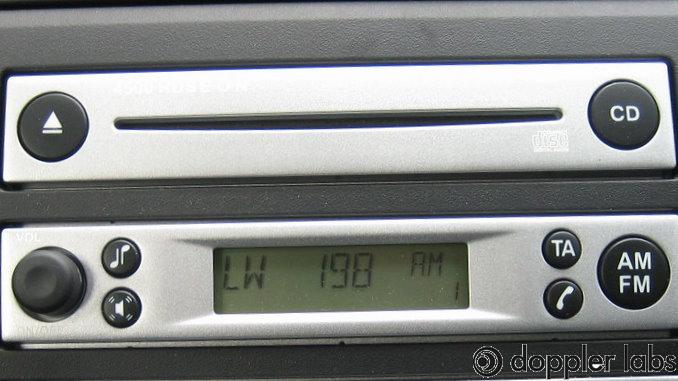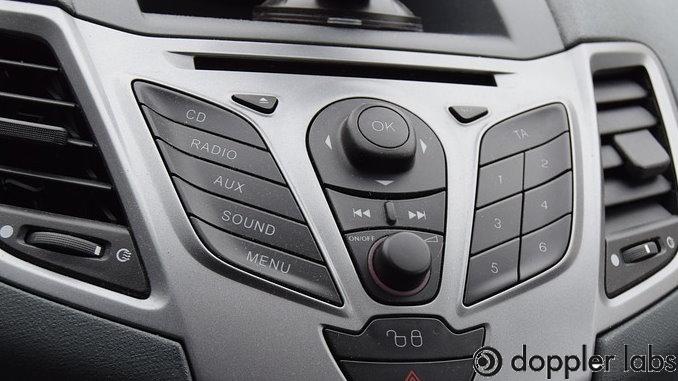- How Does A Bluetooth FM Transmitter Work?
- What Is A Bluetooth FM Transmitter?
- How Does A Bluetooth FM Transmitter Work?
- Stage 1: Pick up the frequency
- Stage 2: Release electromagnetic waves
- Stage 3: Adjust the signal
- Key Features Of A Bluetooth FM Transmitter
- Bluetooth connectivity
- USB ports
- Info display
- Frequency selection
- Audio distortion
- Frequently Asked Questions
- 1. Which devices can I link to the transmitter?
- 2. What is frequency setting best for excellent sound quality?
- 3. Does an FM transmitter work without an antenna?
- Conclusion
- Best Bluetooth FM Transmitters 2023
- Best Bluetooth FM Transmitters for the Car
- 1. VicTsing Bluetooth FM Transmitter
- Features
- Pros
How Does A Bluetooth FM Transmitter Work?
We will discuss the working process of this device in detail. Let’s follow our post!
What Is A Bluetooth FM Transmitter?
Bluetooth FM transmitters are inexpensive and easy devices that allow you to transmit audio from your smartphone to your automobile while also enabling you to have phone calls.
The transmitter helps you connect a phone to a vehicle’s radio without the need for extra wires or the purchase of more costly Bluetooth equipment.
There are two kinds of the transmitter in the market:
- Basic : An FM radio transmitter’s simplest type is a 12-volt connector with a built-in wireless chip. Using this installation, it can connect to a smartphone and stream music over an FM frequency .
- Multifunctional : More sophisticated FM transmitters integrate many features into a compact device. They can help with hands-free chatting, music data, and on-the-go gadget charging, in addition to music streaming.
Transmitters allow for sound delivery from your phone to your car
How Does A Bluetooth FM Transmitter Work?
The transmitter turns the sound signal from a pre-existing input, such as your vehicle’s stereo, to analog sound waves.
The transmissions then turn to FM signals, allowing drivers to adjust the frequency of their car stereo to fit the transmitter.
To be more detailed, we will break the whole process of transmitting the sound signal to analog sound waves into three stages:
Stage 1: Pick up the frequency
These transmitters link to the smartphone’s headphone or earphone jack and then send the signal across the transmission band of an FM frequency, allowing any adjacent stereo to pick up.
An oscillator, which produces a carrier wave at a specific frequency, is necessary to operate a sound transmitter. When a particular signal has to be controlled, the voltage modulator comes into play.
If the modulator is unavailable, the frequency arrives with the preset signal. Following that, the FM signal moves into space via an antenna.
Stage 2: Release electromagnetic waves
The path of a signal starts with sine waves. Before it starts the mission, it has no data encoded in it. The signal receives encoded data once it gets the electromagnetic waves .
The delivery of radio signals occurs when the input turns into sine waves and moves. People utilize frequency alteration to adjust the wavelengths of sine waves before transmitting them to FM devices.
The carrier frequency is near the rate at which electrical signals travel through the broadcast antenna.
This movement causes an electromagnetic field to develop, releasing electromagnetic waves.
Stage 3: Adjust the signal
The receiving antenna sends those produced carrier waves at a chosen frequency. As a result, the antenna receives a substantial amount of radio waves.
Then, you can use a tuner to adjust the channel or the targeted radio station.
Next, the detector on the stereo transforms the broadcast station’s sine wave into audio, which the amplifier boosts. A station with a more robust tower is likely to have better transmission.
The device works with wavelengths during the process
Key Features Of A Bluetooth FM Transmitter
The transmitter can work well thanks to its key features, including:
Bluetooth connectivity
This feature is what makes the transmitter wireless. The device’s Bluetooth connection allows it to link to a cellphone without the use of cables.
Nevertheless, certain FM transmitters do not have Bluetooth capabilities and instead depend on a basic audio wire to attach to the smartphone.
USB ports
Built-in USB sockets are essential if you charge your gadgets on the move using a 12-volt plug. Big transmitters often have one or two ports for this purpose.
It’s worth noting that the sort of USB ports provided is essential. Current USB 3.0 or above are excellent for charging the most recent smart gadgets.
Info display
Advanced audio systems offer helpful info about the audio and play it.
For example, just glancing at the display will tell the song’s author, title, and singer.
Such data can be present on a built-in LCD and LED display in some transmitters. Others can also show this data onto the audio display to read/convey the info.
Frequency selection
The device needs the correct frequency to identify the suitable channel to broadcast. Most simple units require you to scan the frequencies to locate one manually. Higher-end broadcasters can also automatically detect a channel.
Audio distortion
Because music is broadcast on FM channels, getting a good audio signal might be challenging. Audio distortion is possible based on the technology and receiver.
Higher-end transmitters with noise-cancellation features are an excellent choice to address this problem.
Tuning the car stereo is also an effective approach. This video shows you how to do it properly.

Outstanding features enable the device to perform well in your car
Frequently Asked Questions
Here are some frequently asked questions about wireless FM transmitters and how to use them correctly. Let’s check!
1. Which devices can I link to the transmitter?
Any device with an audio input and the ability to link to the tool wirelessly or an aux wire is acceptable.
It’s worth noting that not all transmitters have an aux connector. Your best chance is to utilize Bluetooth-enabled devices.
Many transmitters additionally include an SD memory slot. You may listen to music directly from the card by inserting it into the slot on such gadgets.
2. What is frequency setting best for excellent sound quality?
You need to choose a sound transmission channel from the connected device when utilizing your tool.
There are many accessible channels on the stereo, but some can be more susceptible to interference than others.
You should seek a frequency below or above 0.2 Mhz of an adjacent broadcast to prevent interference.
3. Does an FM transmitter work without an antenna?
Yes. The antenna is not compulsory for connecting. You may still enjoy music via radio stations if your vehicle’s antenna has broken down or if the antenna is absent.
Conclusion
A wireless FM transmitter may give you multiple innovative and user-friendly features with the advanced development of technology.
When determining which radio type to buy, think about the features that will be most helpful for your driving needs.
Hopefully, you will find this article helpful. Thank you for reading!
Noah Kraft
I’m the founder of Doppler Labs, a company famous for Here One wireless headphones. In this site, I will review the best and most outstanding audio products for you.
Best Bluetooth FM Transmitters 2023
A Bluetooth FM transmitter will let you stream music wirelessly from your phone through your car’s FM stereo. You could use it to listen to MP3 files, podcasts, internet radio or streaming services like Spotify.
You can also use a Bluetooth FM transmitter to take hands-free calls or use Google Maps as a sat-nav.
Most Bluetooth FM transmitters plug into your car’s cigarette lighter.
You tune both your car radio and the FM transmitter to an unused FM frequency (see this article for advice on which frequency to use).
The Bluetooth FM transmitter essentially acts like a mini radio station that just broadcasts from the device to your car’s stereo.
Getting a Bluetooth FM transmitter is a cheap and easy alternative to replacing your old car stereo if it doesn’t have Bluetooth.
Here’s a roundup of 5 of the best Bluetooth FM transmitters available. All of the products reviewed here offer both hands-free calls and wireless audio streaming.
Best Bluetooth FM Transmitters for the Car
1. VicTsing Bluetooth FM Transmitter
The VicTsing Bluetooth FM Transmitter (model number H-VT-0805) can be used for streaming music from your phone or an MP3 player or taking hands-free calls using Bluetooth.
This transmitter offers an easy and cheap way to upgrade an old car stereo that doesn’t have Bluetooth. You could also use it for listening to online radio via your phone.
Features
- Plays music files in WAV, MP3 and WMA format from a USB drive or MP3 player
- CVC noise cancellation for hands-free calls
- Adjustable neck for changing the viewing angle
- Auto-connects with the last paired phone
- Dual 5V/2.1A USB charging port for quickly charging your phone
- TF card reader
- USB charging port
Dimensions: 12 x 6.5 x 5.7 cm
Pros
- Very easy to use
- Bright and clear LCD display
- Hardly any radio interference
- Good value for money



